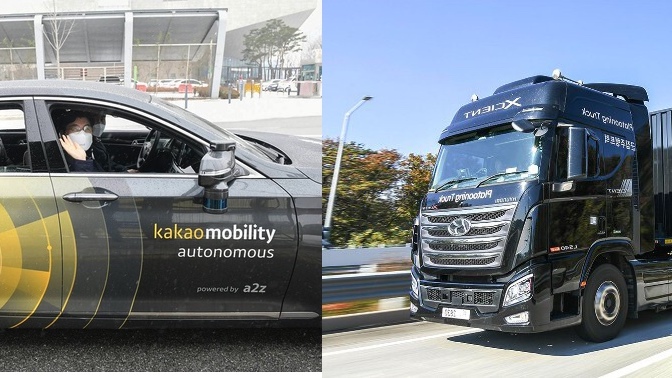A couple of announcements caught our attention last week regarding AI-controlled cars. South Korea’s Kakao Mobility and local startup Autonomous A2G launched a limited self-driving taxi service in Sejong City this month, made possible by enabling legislation passed in May. For now, the service is restricted to government employees, and the AI driver will be backed-up by an engineer who is there to monitor the systems and take over in an emergency. The companies plan to expand the fleet and service areas this year, although no details are given.
Another announcement comes from the Ministry of Land, Infrastructure and Transport about the on-going successes of the semi-autonomous truck platooning program. This is a collaboration between the Korean Expressway Corporation, Kookmin University in Seoul, and Hyundai Motors. Previously restricted to a designated test road called the Yeoju Smart Highway, the program is now being tested on public roads at speeds up to 70 kph. This year the program will expand to platoons of 4 trucks running at 90 kph. We’ve always thought that long-haul trucking and freight industries would be an early adaptor AI technologies, and one which AI could offer significant benefits.
















> engineer who is there to … take over in an emergency.
One day we’ll get it right and have the computer take over when the human screws up and not the other way around.
Congratulations. They’ve invented the train.
Oh, and “km/h”, please.
Australia: hold my “Foster’s”…
https://www.youtube.com/watch?v=0iFkKRh5kcM
There are already in use in Australia using a rather older mechanical and pneumatical link
kmh would have been incorrect, but the article has kph – which is fine and doesn’t need to be changed to km/s. ie kph is Kilometers Per Hour… See https://en.wikipedia.org/wiki/Kilometres_per_hour
SI units, please. And obviously km/s is a typo caused by lack of care on your part.
kthxbye.
Yep they reinvented the train and found another way to put more people in the unemployment line. Though in terms of fuel efficiency and sheer toonage they cannot come close to the long haul trains that are now over a mile long.
Trucks can go where it is too costly to build railroads.
Trucks can negotiate steeper inclines than trains (inclined railroads are a rare exception).
Trucks can haul small loads more efficiently to a particular location more efficiently than a railroad.
Truck platoons can disperse and go to separate locations or join other platoons more efficiently than switching railcars.
Trucks can drive on dry lake beds or gravel roads.
Trucks can also haul railroad cars where railroad cars can’t normally go. :D
And trains haul many thousands of truck trailers every day on intermodal consists. Often one to two miles long at a time and it only takes a crew of 2.
Try that with your toy truck platoons. Oh that’s right you can’t,
It’s almost as if they are good at different things! Given the global distribution network uses both extensively I think you two must be the only people stupid enough to think it’s an either/or choice.
Truck platoons don’t exist,
For long distance bulk hauling nothing beats rail in terms of fuel efficiency and sheer tonnage.
Trucks can go where rail can’t but that is thanks to tax payer subsidizing of highways and roads. RR’s don’t have that sort of welfare.
Dry lake beds are rare and gravel roads are primarily used by construction vehicles not 18 wheeled AI machines(which don’t exist).
Literally every lightweight transport (with higher Lift capacity/Vehicle weight ratio) started from a personal transporter with generator on your back and up to lightweight Diesel/Stirling-electric road train on CNG/LPG and if you in particularly sunny place even cheaper with PV/STC+FPSE even both in combination, maaaaaybe Dish Stirling but I never seen something this grotesque IRL.;D
It won’t work. On Polish highways, say S7 or A2 engineer would keep “taking over in case of emergency” so often he might as well be employed as a driver. Driving in EU, for example in Germany or UK is very safe because people obey laws and police are doing their job. Driving in eastern European countries like in Belarus, Poland, Ukraine or Russia is madness because after passing exams drivers quickly learn that the one who’s polite on the road is the one who ends up being overtaken all the time (at best!). Police are corrupt and road violence is commonplace.